


Swiss cuisine is often associated with cheese and milk chocolate, and that’s quite fair. Indeed, Switzerland's high-altitude pastures give rise to an abundance of dairy products. However, the country's food scene is a diverse tapestry that goes far beyond. Each of the country’s 26 cantons offers a unique experience influenced by neighboring German, French, and Italian culinary traditions. With its breathtaking mountains and chilly winters, hearty and comforting dishes reign supreme. The basic ingredients are cheese, various meats, and potatoes. Traditional Swiss cuisine may appear too simple, but who said simplicity can’t be incredibly delicious? For those eager to embark on a culinary adventure through the country, Zurich is an ideal starting point. Let’s take a look at some authentic local food you should try in Switzerland's largest city.
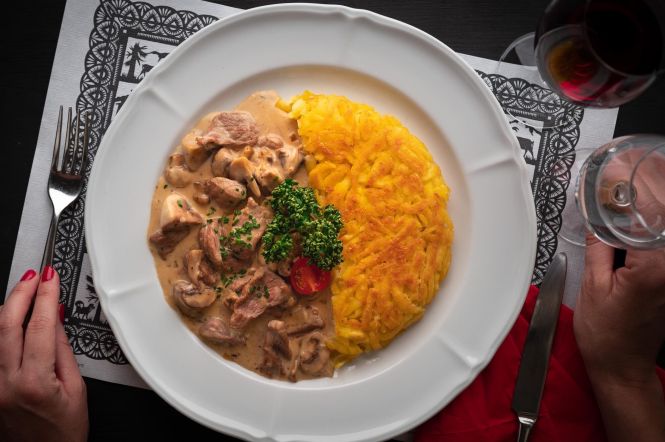 Rosti at Swiss Chuchi restaurant, Zurich
Rosti at Swiss Chuchi restaurant, Zurich
Originally recognized as a hearty farmer's breakfast, Rösti is now regarded as a national Swiss dish. Simple yet satisfying, it features grated potatoes fried to a crispy golden perfection. It is often referred to as the Swiss version of hash browns made in the shape of a large pancake and then cut into individual pieces. It can be enjoyed as an appetizer or as a side dish for the main meat course. While the classic rösti recipe uses only potatoes, there are more variations, incorporating ingredients like eggs, bacon, apples, and cheese. We highly recommend giving them a taste at the renowned Kronenhalle restaurant.

Schnitzel in Czech and Slovakia will be a great addition to any garnish, especially it is combined with mashed potatoes and fresh salad. Crispy golden crust and a delicate aroma will conquer your heart!
Nestled in the heart of Zurich, Kronenhalle stands as one of Switzerland's most iconic fine-dining establishments. It is remarkable not only as a culinary hotspot but also as a captivating art gallery. As you step into its sophisticated dining space, you'll find yourself in the midst of genuine masterpieces by Chagall, Picasso, and Miró. The menu features classic French-influenced Swiss dishes and seasonal specialties.They serve perfect Rösti as a side dish to the restaurant’s legendary filet of veal, sliced calf's liver with onions, breaded veal escalope, and beef tenderloin with pepper. At Kronnenhalle, wine takes central stage in the dining experience. Whether you're seeking rare Bordeaux selections, exquisite Tuscan wines or Portuguese Douro, their extensive wine list is sure to impress and elevate your diner.
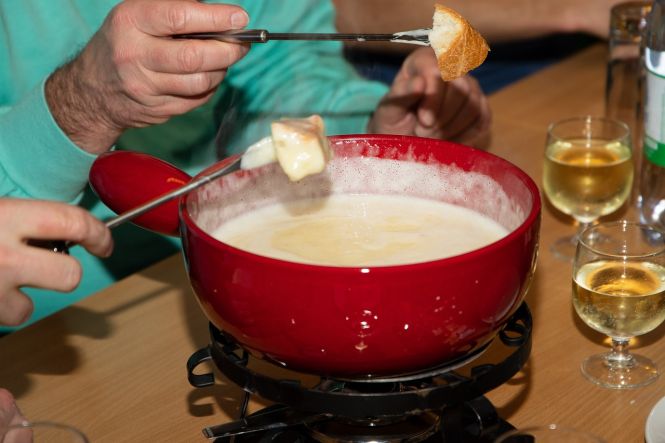 Fondue, Cheese, Melt image. Image by marcelkessler from Pixabay
Fondue, Cheese, Melt image. Image by marcelkessler from Pixabay
When it comes to local Swiss food, cheese fondue may seem a cliché, but it is a delicious one. The authentic taste of this warm, gooey delight is an absolute must when you visit Switzerland. While cheese, wine, and seasoning remain fundamental components, there are many other variations to explore. The origins of this comfort food can be traced back to the 18th century, when farm families looked for ways to stretch their limited supplies during the long winter months. Today, fondue has become a symbol of national unity. It is the ultimate social dish, inviting communal dipping and sharing, that can do it all: warm up chilly winter nights or add a touch of elegance and romance to your cozy dinners and gatherings. But remember, as you savor your fondue, beware of your bread! If a man loses his slice in the pot, tradition dictates he should buy a round of drinks. As for the ladies, a dropped bread means sharing kisses with those nearby.

It's a dish made of melted cheese and white wine. Two kinds of cheese are melted in the hot wine. Then spices are added. Fondue is eaten hot right from the pot by dipping pieces of white bread or vegetables with special forks.
Located in the center of Niederdorf, Swiss Chuchi is the number-one address for authentic cuisine. The welcoming restaurant remains steadfast in its commitment to preparing dishes in old Swiss traditions. Offering great portions for a reasonable price, it has earned a well-deserved reputation as the go-to destination for cheese fondue and meat specialties. It boasts an extensive selection of up to ten different variations of the dish, such as Adler’s special cheese fondue, made with a mix of aged cheeses, white wine, cherry liquor and garlic; vaudois fondue, made with four cheeses; or traditional fondue with a shot of Swiss whisky. With each option more tempting than the last, you'll find the one that perfectly matches your taste.
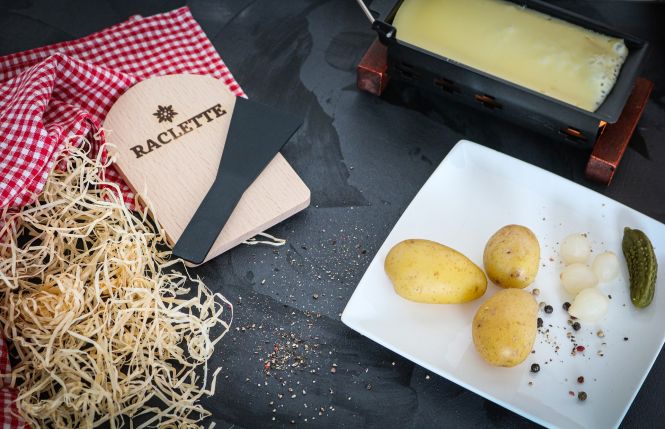 Raclette, Cheese. Image by Dijana from Pixabay
Raclette, Cheese. Image by Dijana from Pixabay
Raclette is a full dining experience that evokes the heartwarming essence of tradition. This winter dish traces its roots to the Swiss mountain shepherds from the canton of Valais who gathered around a crackling fire to roast potatoes hundreds of years ago. They noticed that a piece of cheese placed near the fire began to melt and scraped the molten cheese onto their potatoes. At this moment of inspiration, raclette was born. By the way, the name derives from the French word "racler" which literally means to scrape. Today, the melted cheese is served over boiled potatoes, assorted cured meats like bündnerfleisch, and vegetables, accompanied by bread, cornichons, and pickled onions on the side. Though raclette is known as a famous after-ski dish, you don’t have to go to the Alps to enjoy this culinary tradition. You can also savor raclette in its finest form in Zurich.

Traditionally raclette is a dish is of melted cheese and boiled potatoes served with small gherkins and pickled onions along with dried meats, ham, and sausages, etc.
Following its name, this eatery offers some of the best raclette in Zurich. Conveniently located and easily accessible, it promises an unrivaled experience, serving this dish all-you-can-eat style, accompanied by boiled potatoes and mixed pickles. Raclette Stube has a good selection of wines, and the staff is more than happy to provide recommendations, ensuring the perfect pairing with the creamy, savory notes of the cheese. Its rustic charm, accentuated by wooden furnishings and warm lighting, creates an atmosphere that is both welcoming and cozy. While the menu may be relatively small, the quality of products is exceptionally good. Other options you can relish here are salads, charcuterie, cheese fondues, and desserts.
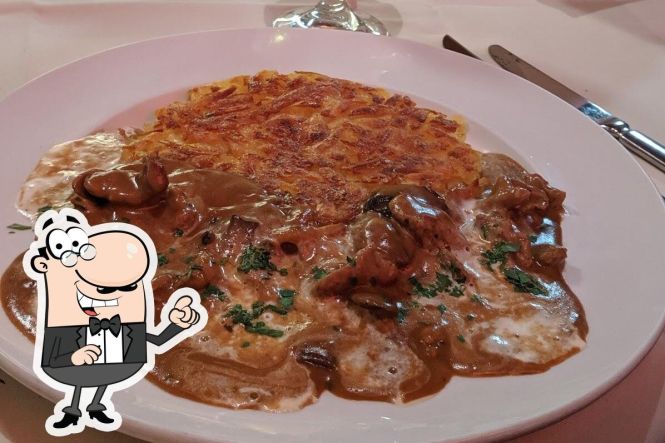 Zürcher Geschnetzeltes at Zum weissen Kreuz, Zurich
Zürcher Geschnetzeltes at Zum weissen Kreuz, Zurich
Originated in Zurich, this relatively modern Swiss stew was first mentioned in the late 1940s but quickly gained international acclaim. Zürcher Geschnetzeltes, translated as "Zurich sliced meat", features pan-fried veal often accompanied by mushrooms in a luxurious creamy white wine sauce. It can be served with Rösti, pasta, rice, or mashed potatoes. Although veal is the traditional choice for the recipe, it can be substituted for pork or chicken. For an authentic taste of this local specialty, we recommend visiting Zum weissen Kreuz.
This charming restaurant boasts a warm and rustic ambiance, complete with traditional furnishings, creating an atmosphere that transports you back in time. Zum weissen Kreuz is one of the best spots to truly experience Zurich. With a focus on prompt service and outstanding cuisine, this restaurant delivers an exceptional price-performance ratio that won't disappoint. Their emblematic Zürcher Geschnetzeltes accompanied by the famous Rösti cooked to perfection is definitely worth trying. For those who visit on a warm day, the restaurant offers a nice terrace where you can savor local food amidst the city’s vibrant ambiance.
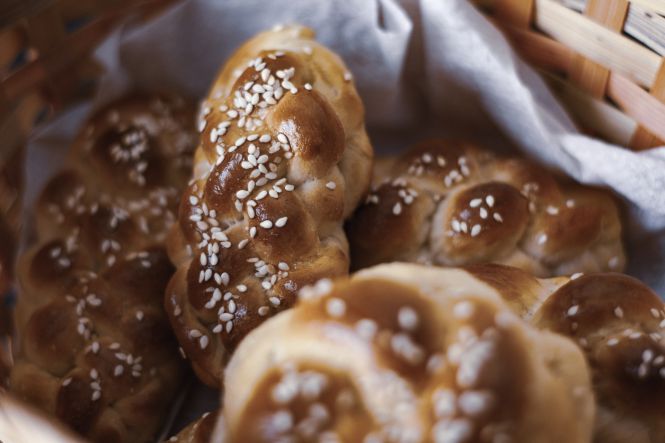 Bread, Braided, Challah. Image by Svetlana from Pixabay
Bread, Braided, Challah. Image by Svetlana from Pixabay
Zopf or Butterzopf is the traditional bread of Switzerland, instantly recognizable by its soft, spongy texture and signature braided appearance. The secret to its taste is the generous use of butter. While it may seem like just bread, Zopf holds a special place in the hearts of Swiss people and is an essential part of Sunday mornings throughout the country. Indeed, topped with jam or butter, it tastes amazing with a steaming cup of fresh coffee. This bread originated in the canton of Bern in the late Middle Ages. A popular legend says it appeared as part of an ancient burial ritual. At that time, when a woman’s husband died, she was required to cut off her braided hair and put it in the tomb. Later, this custom evolved into burying a braided Zopf loaf instead. Nevertheless, it’s just a tale. But the allure of Zopf is very real.

Simple and elegant traditional Swiss white bread in the form of a braid.
Hausamman is a top destination for Zopf enthusiasts, acknowledged by critics and connoisseurs. Their secret recipe has been refined to perfection over the years, resulting in a mouthwatering and irresistibly buttery loaf. Hausamman offers timeless classic Swiss bread, as well as its poppy seed version and a bite-sized one. You can also enjoy freshly baked croissants and different kinds of pastry here. A cup of good coffee will perfectly pair with your Zopf experience.
We hope this guide has been a source of inspiration for your next Zurich trip. The city has many traditional restaurants to choose from, so we encourage you to embark on your own Swiss culinary journey. And don’t hesitate to share your thoughts and impressions of the local cuisine in the comment section below.

2 comments
I had cheese fondue in Switzerland and it was absolutely delicious. Can't wait for the next trip to try other specialties!